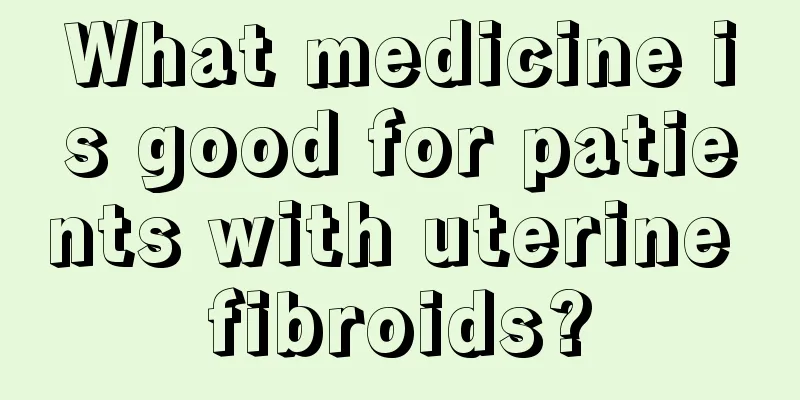What medicine is good for patients with uterine fibroids?

|
Uterine fibroids is a common gynecological disease. With the increase of life pressure and mental stress, many people suffer from common gynecological diseases of the reproductive glands such as uterine fibroids. Due to the different growth locations, they can be divided into intrauterine fibroids and some submucosal fibroids, cervical fibroids and so on. Different types of uterine fibroids have different main symptoms. The main symptoms are a lower abdominal mass and some difficulty urinating. Uterine fibroids mainly occur in women between the ages of 20 and 50. Many people choose the principle of drug treatment, which mainly adopts some treatment methods for different symptoms of fibroids. At the same time, the principle of medication is mainly to prevent infection and some symptoms such as mild anemia. Treatment principles 1. Follow-up observation: Suitable for patients with small fibroids and mild increase in menstrual volume. 2. Androgen therapy: Suitable for near-menopausal patients whose fibroids are not large and whose menstrual flow is not significantly increased. 3. Surgical treatment: It is the main treatment method for this disease. Misfetil treatment: suitable for preoperative treatment of large uterus and heavy menstruation. Medication principles 1. Postoperative infection prevention and fluid replenishment can be administered according to the limit "A". 2. Patients with mild anemia can be given medication according to the limits "A" and "B". 3. If there is secondary anemia or excessive bleeding in the hands before the operation, blood transfusion or human albumin can be given according to the degree of anemia. Expectant management means regular follow-up observation without the need for special treatment. It is mainly suitable for patients with uterine fibroids whose size is less than 5cm and who are asymptomatic or have mild symptoms. If they are near menopausal women, it is expected that the fibroids will shrink naturally after menopause. Follow-up examination should be conducted every 3 to 6 months, and during the follow-up period, attention should be paid to the occurrence of any symptoms and whether the uterine fibroids have enlarged. A gynecological examination and B-ultrasound examination are required at each follow-up visit. If symptoms of menorrhagia, compression or rapid enlargement of the fibroids occur during follow-up, appropriate treatment should be adopted in a timely manner. Expectant management of asymptomatic uterine fibroids is appropriate under regular follow-up monitoring. It should also be noted that in a small number of postmenopausal patients, uterine fibroids do not shrink but instead grow larger, and follow-up should be strengthened. The above is how to use medication to treat uterine fibroids. The principle of choosing drug treatment in daily life is mainly to use some different treatment methods for fibroids and various symptoms. At the same time, the principle of medication is mainly to prevent infection and some prevention of mild anemia and other symptoms. In life, we can connect with some previous dietary adjustments and reservations. For uterine fibroids, we must carry out good adjustments and care. |
>>: Symptoms of endometrial thickening
Recommend
Yellow-green leucorrhea, odorless and non-itching
Leucorrhea is secreted from the vagina, but it is...
How to stimulate ovulation in polycystic ovary syndrome?
Polycystic ovary syndrome is a disease that troub...
Endometrium 13mm but no menstruation
What are the reasons for the sudden delay of more...
Popular Science | Are you still lying on your stomach for a nap? Beware of myopia!
As the weather gets colder, it is easiest to feel...
What causes high prolactin in women?
For female friends, when they go to the hospital ...
Where is the fetus at 100 days of pregnancy?
Week 13 is the beginning of the second trimester,...
Artificial insemination steps
Artificial insemination is a relatively special w...
What should you pay attention to during sex during pregnancy
Sexual life can promote the relationship between ...
Episiotomy wound with granulation picture
When giving birth, many mothers choose natural bi...
Looking up at the computer and looking down at the mobile phone, you will feel dizzy, painful and numb, and you need to be alert in your neck!
"Looking up at the computer and looking down...
What to do if you sweat during the month
It is said that mothers are the greatest people i...
Difference between biochemical pregnancy and ectopic pregnancy
Biochemical pregnancy and ectopic pregnancy are b...
Is it good for women to wear carbonate jade?
Sulfide jade is divided into "white marble&q...
Can I use a belly belt after a caesarean section?
Mothers experience a process in which their abdom...
What is the secret of women's skin care
I believe everyone knows the importance of skin c...









